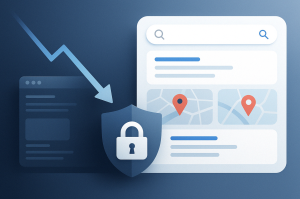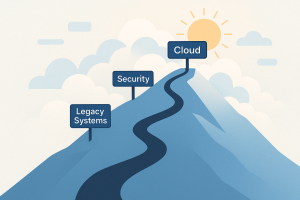In a world where data is king, understanding the tools that handle this data becomes crucial, especially for decision-makers in businesses. This article aims to demystify GraphQL, in an attempt to uncover its real-world value for business projects. Is GraphQL merely one more tech trend, or does it offer tangible, long-lasting benefits for complex business environments? We will delve into this question, providing insights that are both technically sound and easily digestible for those steering the ship in today’s digital ocean.
Why was GraphQL created?
GraphQL stands as a modern query language, a technology created by Facebook in 2015, revolutionising how developers interact with APIs. But why did they even bother to create this technology?
Well at the start of the decade of 2010 facebook was performing strong updates to its mobile applications in an attempt to catch up with the high increase in usage of mobile devices. During this change facebook was updating many of the APIs to REST apis that would be consumed by the mobile application. Those changes brought together a few challenges though:
- With a REST api you can either have many endpoints where each returns a specific part of the data you want, or you have fewer endpoints returning a lot of data that you might sometimes not need to always be together.
This causes a fight to search for the sweet spot of not having too few or too many endpoints, but despite this fight usually, for maintainability, it is common to end up with many endpoints, mostly in big scale projects such as facebook. This naturally causes an increase in the number of requests that are needed to build a page of the application, and as each request that an application performs takes time, having multiple requests can impact the performance of the application.
- The next point is that REST apis return the data with a specific structure predefined by the developers that create the api. If new features have to be created or something has to be updated, in a way that makes the structure change, this can cause issues in the application that is consuming the api. This creates a coupling between the API and the application consuming it given that changes on the API have to be carefully controlled to match what is expected by the application.
Because of those issues GraphQL was developed. Unlike traditional methods, GraphQL empowers users to precisely ask for what they need. Imagine a digital waiter who brings exactly what you order – no more, no less. This approach streamlines data retrieval, making it highly efficient and tailored to specific requirements. It’s like having a custom conversation with your data, ensuring you get relevant and concise information without unnecessary extras, and doing all that while always talking to the same endpoint. So ask exactly what you need always from the same person. This helps developers to live in the sweet spot that was difficult to find in the REST apis. You only get data that you want, without having multiple requests. For every situation you can create a well balanced approach.
Ok that sounds great, so all that is impossible without GraphQL?
Well not that all, you can create the same thing with different technologies and even in REST apis! You could create REST apis that just have a few endpoints or just one endpoint and each one can be modified dynamically to return only the data you need, and this approach is very often implemented by knowledgeable backend developers. You can create organised and complex architectures to keep this approach with REST api maintainable by a large number of developers.
So why then are we talking about GraphQL? Well because GraphQL was the first time where all those different approaches were standardised, together with that it was one of the first technologies to bring a set of tools ready to use for apis with those needs. This makes the development of new apis that can have this capability much quicker than before. Even if you can use many other technologies to achieve the same, normally the effort to get in the same level of all the features that GraphQL offers is much higher using other technologies.
Mainly because this is just the start of GraphQL, we talked about the main principle that ignited the creation of GraphQL but from that many features flourished.

Advantages of Using GraphQL in Business Projects
In the ever-evolving landscape of business technology, GraphQL emerges as a a great help, offering distinct advantages:
Efficient Data Retrieval
Imagine having a shopping list tailored exactly to your needs — that’s what GraphQL does with data. It eliminates the ‘one-size-fits-all’ approach of traditional APIs, allowing precise data requests. This efficiency reduces unnecessary data exchange, saving time and resources.
Improved Performance
GraphQL’s targeted data retrieval method isn’t just about getting what you need, it’s also about speed. By avoiding the retrieval of irrelevant data, and fewer api requests, the system can run smoother and faster. For businesses, this can translate to lower loading times and a more fluid user experience, which is essential in a world where speed often is equivalent to customer satisfaction.
Real-Time Data with Subscriptions
For many applications more importantly than only making requests to the API is guarantee that the data is being handled in real-time, like a messaging app. GraphQL offers subscriptions, a feature allowing instant data updates. This is similar to getting live stock market updates instead of yesterday’s closing prices. This again is of course possible without GraphQL, but the structure of GraphQL can bring this important requirement of real time data that some applications need, with much less effort for the developers.
Enhanced API Discoverability and Documentation
For any consuming the API exploring and understanding what data is available is very important, and this becomes intuitive with GraphQL. It’s like having a well-organized file cabinet where everything is labeled and easy to find. This clarity is invaluable for developers, reducing the time and effort needed to integrate and utilize various data systems. This comes already often build-in when using GraphQL.
Frameworks and beyond: Apollo GraphQL
With the growth of GraphQL there are numerous technologies built on top of it that further enhance it with more and more features that are relevant for growing businesses. A big example is Apollo GraphQL that offers built- in caching, Apollo federation and supergraph concept for microservices architectures, and many more features that can be relevant to your business and boost the development time.
Better Developer Experience
In general the fact that many of the important features and needed capabilities can come already built-in with GraphQL, the development experience is extremely enhanced and boosted. Developers can quickly create a very complex API that can merge data from many data sources and use real time data, with much less effort and with everything documented for whoever needs to consume this API.
GraphQL in Complex Business Platforms
GraphQL’s strengths can bring my advantages to many business needs. Below we are presenting some of the main benefits that can be easily noticed when using this technology.
Handling Complex Queries and many data sources
In the realm of complex business applications, data structures and its relationships can become a huge spider’s web. GraphQL excels here by allowing seamless queries across diverse data types, data sources and relationships. It’s similar to conducting an orchestra where each instrument (or data source) plays in harmony, providing a comprehensive and coherent performance (or data output). This capability is invaluable for businesses that need to make sure to keep a maintainable system, while integrating new data from different places.
Scalability
As businesses grow, so do their data needs. GraphQL is designed to scale with this growth. Its flexibility in handling queries makes it adaptable to increasing data volumes and complexity, similar to a building with a strong foundation and the ability to add more floors as needed. This scalability ensures that the data infrastructure won’t crumble under the weight of expansion.
Security Aspects
Navigating the landscape of data security is crucial for any business. GraphQL offers robust mechanisms to handle security concerns. Techniques like rate limiting (controlling data request frequency) and query complexity analysis (preventing overly complex or harmful queries) act as vigilant gatekeepers, ensuring data exchanges are secure and efficient. And as often with GraphQL all that can come with very little development effort for a team working with GraphQL and technologies based on GraphQL.
Case Studies
The best way to display all of the advantages of GraphQL in Real-world scenarios is to bring cases of success using GraphQL. There are innumerable examples of that, and two big examples that can be highlighted are the use of GraphQL on Facebook and Netflix.
In the case of Facebook it was already displayed how they created that technology to allow them to better implement their mobile application. The new technology was a way to allow the application to not have the issues they were hitting with RESTful approach, having performance issues with many requests or getting a lot of data that was not useful for each page for example. That was extremely relevant, mainly at that time where phones were not as powerful as today, and facebook was trying to create a better mobile experience.
In Netflix a post called “Beyond REST” displays how GraphQL and Graphile (A technology on top of GraphQL) allowed a rapid development of a very efficient API that played perfectly with the microservice architecture of the company. As stated by the author of the post: “The successful implementation of an internal app over 4–6 weeks with limited initial requirements and an ad hoc distributed team (with no previous history of collaboration) raised a large amount of interest throughout the Netflix Studio.”

Critique - Just a Fancy Trend?
While GraphQL boasts numerous advantages, it’s vital to approach it with a balanced view, acknowledging potential drawbacks and assessing its long-term viability in the business world.
Critique of GraphQL
Firstly, GraphQL’s flexibility can be a double-edged sword. Complex queries, if not managed properly, can lead to performance issues. This is akin to a chef trying to prepare a multi-course meal single-handedly, without proper organization, the kitchen (or the api) can become overwhelmed. Additionally, client-side caching in GraphQL isn’t as straightforward as in traditional REST APIs, potentially leading to more complexity in managing stateful client applications.
Balancing the Hype
The tech world often witnesses trends that burn brightly but fade quickly. Is GraphQL one of them? While it’s true that GraphQL has gained significant momentum and popularity, it’s important to distinguish between trendiness and actual utility.
The sustained interest and adoption by major players like GitHub and Shopify suggest a deeper value beyond just a passing trend. However, businesses must consider their specific needs and constraints. What works for a tech giant may not suit a small startup or a company with limited technical resources.
Like any technology, GraphQL is not a one-size-fits-all solution. It offers substantial benefits, especially in managing complex data systems efficiently. Yet, businesses should weigh these advantages against their specific needs and the potential challenges of implementation.
Conclusion
So should I really use GraphQL
If your team has some experience with GraphQL, particularly with Apollo Graphql that comes with many useful features or If the data structure of the application is expected to grow and get adapted quickly in the near future, mainly if new sources of data are planned to be integrated. GraphQL and its features most likely will bring some value for your use case.
Also, if any of the numerous features that can come attached to GraphQL frameworks are relevant to your project and the scale of it, or if you already have a REST api that is starting to present the challenges previously mentioned, your team will most likely benefit from using GraphQL.
Now, if you have a team that is primarily focused on building REST apis, and the data structure and the growth of it is easy to plan and predict, you have probably no reason to start the development using GraphQL.
Future Outlook
In general the trajectory of GraphQL seems promising. As businesses continue to wrestle with ever-growing and increasingly complex data, tools like GraphQL that offer flexibility, efficiency, and scalability become increasingly useful and provide a value that will remain relevant in the future.
Even if new technologies come up in the future making GraphQL obsolete, the foundation of the idea and the value it brings to business and the developers will most likely carry on in one way or another.
Yet, even though GraphQL does seem an ideal choice for businesses seeking to navigate the complexities of modern data management, the decision to adopt it, as always, should be rooted in a clear understanding of its capabilities and how they align with specific business goals and challenges. It’s always about choosing the right tool for the right job.






